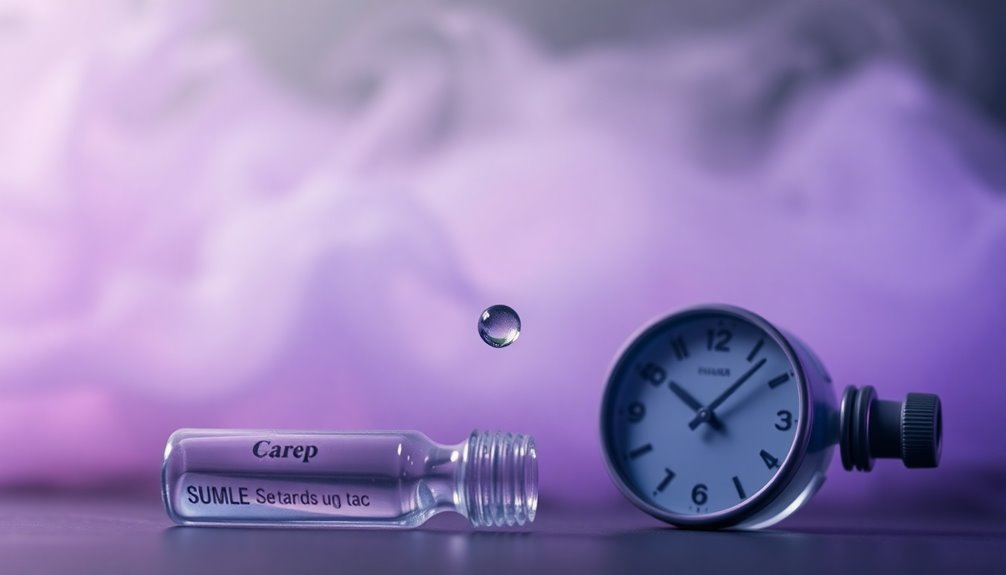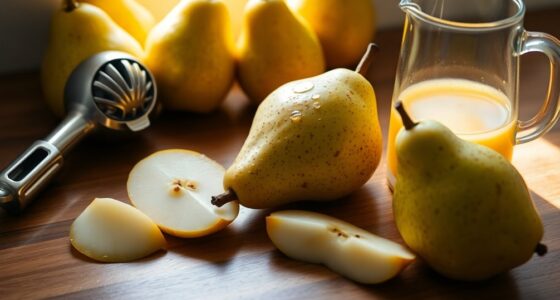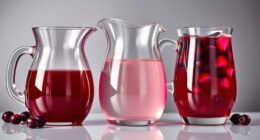Vape juice can stay in your blood for several hours to days, mainly depending on your metabolism, how often you vape, and the nicotine concentration in the juice. Nicotine has a half-life of about two hours, but its main metabolite, cotinine, can linger for up to 10 days. For regular vapers, cotinine might stay elevated for even longer. If you're curious about how different factors play a role in this, there's more to uncover.
Key Takeaways
- Nicotine has a half-life of approximately two hours, meaning it is significantly reduced in the bloodstream within that time frame.
- Cotinine, the primary metabolite of nicotine, can remain detectable in blood for up to 10 days after the last use.
- Regular vapers may have elevated cotinine levels detected for as long as 21 days due to frequent usage.
- Individual metabolism, nicotine concentration in vape juice, and usage frequency all influence how long nicotine stays in the blood.
- Blood tests can provide insights into recent vaping activity, with timing of the last vape session being crucial for accurate interpretation.

Have you ever wondered how long vape juice stays in your blood? It's a common question among vapers and those considering quitting. Understanding the duration that nicotine and its metabolites linger in your system can help you make informed decisions about your vaping habits.
Nicotine, the primary addictive substance in vape juice, has a half-life of about two hours. This means that after two hours, half of the nicotine you've ingested is gone from your bloodstream. However, the story doesn't end there.
When you vape, your body metabolizes nicotine into cotinine, which is the main metabolite that blood tests typically look for. Cotinine can be detected in your blood for a significantly longer period, often up to 10 days after your last use of vape juice. If you're a regular user, this detection time extends even further. Regular vapers may find that cotinine levels remain elevated for as long as 21 days. This is crucial to consider if you're planning to undergo blood tests, especially for employment or health reasons.
Detection times for nicotine can vary based on several factors, including your metabolism, how frequently you vape, and the concentration of nicotine in the vape juice. If you have a faster metabolism, your body may clear nicotine more quickly, whereas slower metabolisms can prolong its presence in your blood.
Moreover, if you're using high-nicotine vape juice, your body will have to process more nicotine, which could affect how long it stays in your system.
It's important to note that the withdrawal effects from nicotine can begin shortly after you stop vaping. These effects can vary in intensity, depending on how long and how often you've vaped. If you're a regular user, you might experience stronger cravings and withdrawal symptoms as your body adjusts to the absence of nicotine.
Understanding these effects can help you prepare for the transition, whether you're trying to quit or just curious about how long it takes for your body to clear nicotine.
Blood tests for nicotine and cotinine offer both qualitative and quantitative results, helping to assess not just whether you've vaped recently, but also how much you've consumed. If you're concerned about your nicotine levels for any reason, it's worth considering when you last vaped and how that correlates with the timing of a potential blood test.
Frequently Asked Questions
How Long Does It Take for Vape to Get Out of Your Blood?
It usually takes about 24 to 72 hours for vape substances to leave your blood, depending on usage frequency.
If you vape occasionally, you might clear most nicotine within a couple of days.
However, if you're a regular user, traces like cotinine could linger for up to a week.
Factors like your metabolism and overall health also play a role in how quickly your body processes and eliminates these substances.
How Long After Vaping Will You Test Positive?
After you vape, you could test positive for nicotine within a few hours.
Typically, nicotine's detectable presence lasts up to 48 hours, while its metabolite, cotinine, can show up for up to 21 days.
If you're a regular vaper, your levels might be higher, extending the time you test positive.
Blood tests directly measure nicotine, but cotinine tests provide a more reliable indication of your nicotine exposure over time.
How Long Does It Take for Vape Liquid to Leave Your System?
After you vape, it typically takes about 1 to 3 days for the vape liquid to leave your system, depending on your usage frequency and metabolism.
If you're a regular user, it might stick around longer, especially since cotinine can linger for up to 10 days.
Staying hydrated and maintaining a healthy diet can help speed up the process.
Individual factors like overall health also play a significant role in how quickly your body clears it.
How Do You Get Vape Out of Your Bloodstream?
If you're looking to clear the air, there are some steps you can take.
First, stop vaping and using nicotine products altogether.
Staying hydrated helps your kidneys flush out toxins more efficiently.
Regular exercise can rev up your metabolism, speeding up the process.
Eating a diet rich in fruits and veggies supports your body's natural detox.
Lastly, steer clear of your vaping triggers to help reduce cravings and make the journey easier.
Conclusion
In conclusion, vape juice can linger in your blood for days to weeks, depending on factors like usage and metabolism. Just like a painting slowly fading over time, the effects of nicotine and other substances gradually diminish. If you’re concerned about its presence, consider reducing your intake or quitting altogether. Your body will thank you, and the benefits of a cleaner system will become evident in no time. Additionally, it’s important to recognize that the duration of these substances in your system can vary widely among individuals. Many people may wonder, “how long does vape juice last” in the body, and understanding this can help guide your decisions regarding vaping habits. Ultimately, making informed choices about your health will lead to a more positive and revitalized lifestyle.
Cindy thoroughly researches juicing trends, techniques, and recipes to provide readers with practical advice and inspiration. Her writing style is accessible, engaging, and designed to make complex concepts easy to understand. Cindy’s dedication to promoting the advantages of juicing shines through her work, empowering readers to make positive changes in their lives through the simple act of juicing.

















